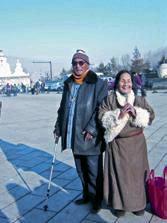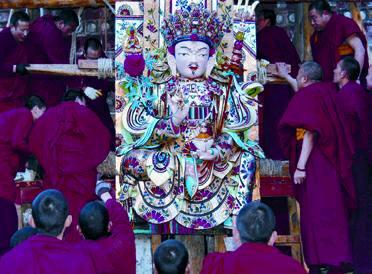Free to Follow
2014-01-28BypanXiaoqiao
By+pan+Xiaoqiao
Since its introduction to the region in the seventh century, Buddhism has become deeply rooted in the culture of the local people of the Qinghai-Tibet Plateau, particularly among the Tibetan ethnic group. All practitioners and believers consider themselves followers of the teachings of the Buddha, Sakyamuni.
Located mostly on the Qinghai-Tibet Plateau, Qinghai Province has an ethnic Tibetan population of more than 1.37 million. Religious activities in Qinghai are rich in their content and diverse in form, and are also protected by the government in accordance with the law.
A holy place
Famous for the three important Buddhist art forms —murals, embroidery and butter sculptures—the Tar Monastery boasts a unique status in Chinas Buddhist culture.
Located 25 km to the southwest of Xining, Qinghais provincial capital, the monastery was built in 1379 to commemorate Tsongkhapa, founder of the Gelug (Yellow Hat) sect, which is one of the four major sects of Tibetan Buddhism.
The monastery attracts a large number of tourists every year. It is a sacred place for practitioners of Tibetan Buddhism who come to worship, study or participate in religious activities.
Godain, 72, and his wife moved to Huangzhou County, where the Tar Monastery is situated, several years ago, so that it would be convenient for them to come to pray and worship here every day, and so they would never miss any Buddhist activities, large or small.
According to Godain, he became a follower of Tibetan Buddhism when he was very young, and his biggest wish for his later years is to come to the monastery every day to pay homage to Buddha.
Aside from believers like Godain, every year the Tar Monastery also receives a number of monks from other temples, who come to study and cultivate themselves. These visiting monks are allowed to stay for a certain period of time after registering with the monasterys management council by presenting their own templesletter of introduction. They dont need to pay any fees and are free to choose when to come and when to leave.
Roger Shouse, a professor of education at Penn State University in the United States, visited the Tar Monastery during his recent travel to China. Roger said, “I appreciate it [Buddhism] very much and I like to study it. I think there is much we can all learn. It helps a person develop some peace.”endprint
A Christian himself, Shouse thinks there is a lot of similarity between Christianity and Buddhism. He said that he enjoys learning about these connections.
Shouse added that although the Tar Monastery is a famous tourist destination, upon visiting it he got a real sense that it is not just for tourists and that it was a place where practitioners could really express their faith.
Eng Keng Chhun, a tourist from Cambodia, said that he had long admired the Tar Monastery and was very excited to come. “It is exciting to experience a Buddhist culture that is different from that of my country,” he noted, adding that he feels that the Chinese Government is doing well in protecting Buddhism and its culture in China.
Exchanges
Almost all of the Tar Monasterys living Buddhas have been to Buddhist temples in other parts of China, such as South Putuo Temple in Fujian Province and Lingyin Temple in Zhejiang Province.
“As Buddhist followers, we believe we are all the same and there are no clear distinctions between us. Although we practice Buddhism in different ways, we respect each others customs and get on very well with each other,”said Lobsing Ongsiu, Deputy Director of the Tar Monastery Management Council. “We observe and learn from each other on how to meditate and teach the younger generation as well as how to manage the monastery, treat believers and protect cultural relics.”
Organized by the State Ethnic Affairs Commission and the State Administration for Religious Affairs, living Buddhas and monks from the Tar Monastery also have the opportunity to communicate with the Buddhist communities in other countries, such as Singapore and Thailand.
The importance of learning for the purpose of better communication and deeper study is widely felt in monasteries across Qinghai. Lobsum Longri is a living Buddha from Ganba Monastery in Yushu. He studied at the Highlevel Tibetan Buddhism College of China in Beijing in 2001 and received a Ph.D. there.
In the college, aside from Buddhism and Tibetan culture and history, Lobsum Longri also devoted time to studying Chinese classical literature. “I hope my knowledge and understanding of the countrys classical works will help me to better research Tibetan Buddhism. The methods I learnt researching classical literature are useful in my study of Buddhist scriptures,” he said.
State assistanceendprint
To ensure that monks can concentrate on the study and practice of Buddhism, central and local governments have worked to help them with their daily life.
The Tar Monastery, for example, is home to more than 770 monks. They have each been given a special card, with which they can receive considerable discounts on medical care. As for the elderly, as well as poor and disabled monks, their pensions and subsistence allowances are all covered by the state. The government also offers funds for the renovation of old and dilapidated houses, so that monks can live in a safe and comfortable environment.
According to Lobsing Ongsiu, between 1992 and 2013, the government allocated around 130 million yuan ($21 million) for the renovation of the Tar Monastery. Surrounding roads as well as the power grid and water supply infrastructure have also been improved.
Cultural authorities also sent experts to the Tar Monastery to help formulate plans for preserving important cultural relics such as Buddhist scrolls and Thangkas, which are paintings on silk with embroidery.
When a 5.2-magnitude earthquake hit Yushu in 2010, 81 monasteries were damaged to differing extents, with Kyegu Monastery, Thrangu Monastery and Damkar Monastery being affected particularly badly. The Central Government allocated 970 million yuan ($160 million) to monasteries in the quake-hit area. Today, with the exception of several seriously damaged monasteries, all of them have had their restoration work completed, with monks already moving back into their accommodations.
Minchin Cerin, 67, is a living Buddha from Yushus Saiba Monastery. His monastery was seriously damaged by the 2010 quake.
“We know that the government would of- fer us money for disaster relief, but we did not expect to receive as much as 970 million yuan($160 million),” Minchin Cerin said. “Without such support, it would be impossible to restore the monasteries and impossible for ordinary people to resume normal lives within a short period of time.”
Charity work
Always remembering that Buddhist practitioners have a responsibility to help the frail, the Tar Monastery set up the Kumbum Tibetan Hospital in 1980, where patients receive treatment by Tibetan medicine.
The monastery also set up its own Red Cross organization. Every year, it dispatches medical teams to attend to people living in remote areas that are not only in the pastoral areas on the plateau, but also in other parts of the country. Living Buddhas and monks treat patients and offer them medicine. They also help to rescue and save people in disaster-hit areas, such as those in Wenchuan County in southwest Chinas Sichuan Province, which was hit by a severe 8-magnitude earthquake in May 2008, as well as earthquake survivors in Yushu.
From 1997 till today the Tar Monastery has donated more than 7 million yuan ($1.15 million) as medical welfare across the nation.endprint
